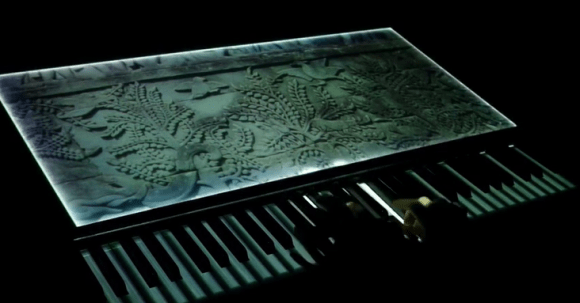
Although director Hayao Miyazaki gets the lion’s share of the credit for the sterling quality of Studio Ghibli’s anime films, you can’t discount the contributions of Joe Hisaishi. The veteran composer’s musical scores are timeless and ethereal, and there’s no better visual compliment to their mix of trepidation and adventurousness than the moving pictures of Japan’s most respected animation house.
The beautiful projection mapping that accompanies this stirring piano cover of the ending theme to Castle in the Sky Laputa is a close second, though.
Beginning with what looks like a stone relief atop the piano being played by YouTube user Faithroom, the first few notes don’t stray far from the original arrangement of the anime classic “Kimi wo Nosete.” Before long, though, the cover appears to slide back, and Faithroom kicks the melody’s tempo up several notches.
Each keystroke of the pianist’s energetic piano version of the song is accompanied by a visual flourish, whether beams of light cascading down like the bricks crumbling from the titular castle in the sky, or a flurry of feathers fluttering around a levitating crystal.
As Faithroom shows once the performance is complete, the background is rendered ahead of time, at a slightly skewed angle. Once projected onto the top of the piano and viewed diagonally, though, it creates the illusion that the flat surface is actually a yawning void.
With the background set, he then connects his piano to a PC, transferring the data from the keystrokes into a system that produces a beam or feather whenever he presses a key.
While “Kimi wo Nosete” is Faithroom’s latest projection mapping muse, it’s not his first. Earlier this year, he took his inspiration from American animation instead of Japanese, with this rendition of Frozen’s “Let It Go,” complete with snow flakes and what look like icicles.
And finally, if you’re an old-school gamer, you’ll probably appreciate this piano version of the ending theme to one of the PlayStation’s most memorable titles, Final Fantasy VIII’s “Eyes on Me,” originally composed by Nobuo Uematsu. It may not feature any projection mapping, but it’s still got plenty of digital artistry
Deeply moving stuff, and best of all, the Laputa video ends with the message “See you next time.” We’ll be waiting, Faithroom.
Source: IT Media
Top image: YouTube
Insert images: YouTube (1, 2, 3)

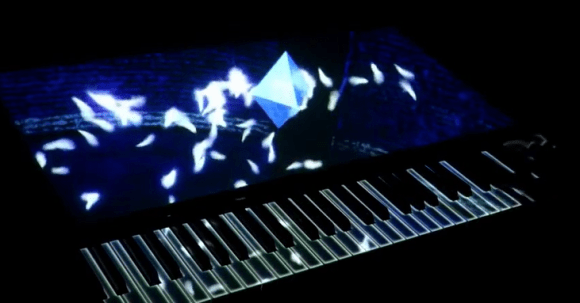
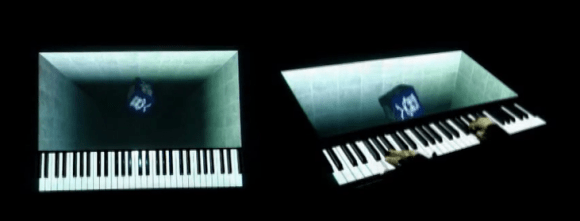
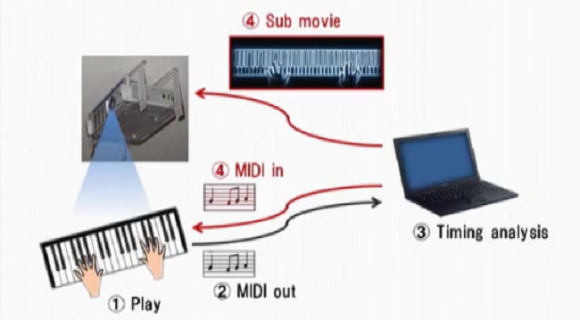
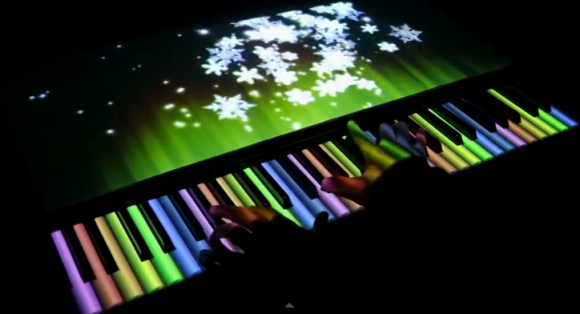

 Beautiful new Levistone from Ghibli’s Laputa anime going on sale soon, so order yours ASAP【Video】
Beautiful new Levistone from Ghibli’s Laputa anime going on sale soon, so order yours ASAP【Video】 Huge Final Fantasy snow sculpture creates epic dragon battle with awesome projection mapping【Vid】
Huge Final Fantasy snow sculpture creates epic dragon battle with awesome projection mapping【Vid】 Final Fantasy VII projection mapping is dazzling guests at Sapporo’s Snow Festival【Video】
Final Fantasy VII projection mapping is dazzling guests at Sapporo’s Snow Festival【Video】 Italian jazz pianist unleashes inner Ghibli fanboy, releases anime theme song album
Italian jazz pianist unleashes inner Ghibli fanboy, releases anime theme song album Another otaku bird? Hayao Miyazaki-loving cockatiel in Japan sings Studio Ghibli cover【Vid】
Another otaku bird? Hayao Miyazaki-loving cockatiel in Japan sings Studio Ghibli cover【Vid】 Hayao Miyazaki says Happy New Year to Studio Ghibli fans with new art for Year of the Horse
Hayao Miyazaki says Happy New Year to Studio Ghibli fans with new art for Year of the Horse We revisited Sweets Paradise after a decade to see if Japan’s dessert buffet still delivers
We revisited Sweets Paradise after a decade to see if Japan’s dessert buffet still delivers 7-Eleven Japan starts new temporary luggage storage service in over 300 branches
7-Eleven Japan starts new temporary luggage storage service in over 300 branches Do you remember giant robots? Full-scale Macross Valkyrie lands in Yokohama
Do you remember giant robots? Full-scale Macross Valkyrie lands in Yokohama That time Seiji called JASRAC to ask why he didn’t get paid royalties for his song being on TV
That time Seiji called JASRAC to ask why he didn’t get paid royalties for his song being on TV Pizza Hut Japan’s hot lucky bags are perfect for a New Year’s pizza party
Pizza Hut Japan’s hot lucky bags are perfect for a New Year’s pizza party Draw like a Studio Ghibli anime artist with exclusive watercolour set approved by Hayao Miyazaki
Draw like a Studio Ghibli anime artist with exclusive watercolour set approved by Hayao Miyazaki We try Kaldi’s microwavable Omelet Rice to find out if it really cooks that easily【SoraKitchen】
We try Kaldi’s microwavable Omelet Rice to find out if it really cooks that easily【SoraKitchen】 NBA team logos – Now with added Pokémon!
NBA team logos – Now with added Pokémon! The mystery destination of the SoraNews24 end-of-year party left us speechless
The mystery destination of the SoraNews24 end-of-year party left us speechless Starbucks Japan ready to get Year of the Horse started with adorable drinkware and plushies【Pics】
Starbucks Japan ready to get Year of the Horse started with adorable drinkware and plushies【Pics】 Cyberpunk anime meets traditional culture in Ghost in the Shell gold leaf Japanese changing screens
Cyberpunk anime meets traditional culture in Ghost in the Shell gold leaf Japanese changing screens 7 great places to see Mt. Fuji from without having to climb it
7 great places to see Mt. Fuji from without having to climb it Hello Kitty Choco Egg figures are an adorable trip through three periods of Japanese pop culture【Pics】
Hello Kitty Choco Egg figures are an adorable trip through three periods of Japanese pop culture【Pics】 7-Eleven Japan’s ramen-cooking robot whipped us up a bowl of noodles【Taste test】
7-Eleven Japan’s ramen-cooking robot whipped us up a bowl of noodles【Taste test】 We found possibly the quietest Japanese-style hotel in Tokyo’s bustling Shinjuku district
We found possibly the quietest Japanese-style hotel in Tokyo’s bustling Shinjuku district Japan’s otoshidama tradition of giving kids money at New Year’s gets a social welfare upgrade
Japan’s otoshidama tradition of giving kids money at New Year’s gets a social welfare upgrade Sumo Sanrio! Hello Kitty and pals team up with Japan Sumo Association for new merch【Pics】
Sumo Sanrio! Hello Kitty and pals team up with Japan Sumo Association for new merch【Pics】 More Than a Capsule Stay: Why Solo Travelers Choose “global cabin Yokohama Chinatown”
More Than a Capsule Stay: Why Solo Travelers Choose “global cabin Yokohama Chinatown” Japan’s oldest largetooth sawfish in captivity back on display in Mie Prefecture
Japan’s oldest largetooth sawfish in captivity back on display in Mie Prefecture Disillusionment at Tsukiji’s tourist-target prices led us to a great ramen restaurant in Tokyo
Disillusionment at Tsukiji’s tourist-target prices led us to a great ramen restaurant in Tokyo Starbucks teams up with 166-year-old Kyoto doll maker for Year of the Horse decorations【Photos】
Starbucks teams up with 166-year-old Kyoto doll maker for Year of the Horse decorations【Photos】 Tokyo considering law requiring more trash cans following litter increase in heavily touristed area
Tokyo considering law requiring more trash cans following litter increase in heavily touristed area Tokyo’s Tsukiji sushi neighborhood asks tour groups to stay away for the rest of the month
Tokyo’s Tsukiji sushi neighborhood asks tour groups to stay away for the rest of the month Tokyo event lets you travel back in time, for free, to celebrate 100 years since Showa era start
Tokyo event lets you travel back in time, for free, to celebrate 100 years since Showa era start Sanrio theme park in Japan announces plans to expand into a Sanrio resort
Sanrio theme park in Japan announces plans to expand into a Sanrio resort Japan may add Japanese language proficiency, lifestyle classes to permanent foreign resident requirements
Japan may add Japanese language proficiency, lifestyle classes to permanent foreign resident requirements Stamina-destroying “Paralysis Noodles” are Tokyo’s newest over-the-top ramen innovation
Stamina-destroying “Paralysis Noodles” are Tokyo’s newest over-the-top ramen innovation Survey asks foreign tourists what bothered them in Japan, more than half gave same answer
Survey asks foreign tourists what bothered them in Japan, more than half gave same answer Japan’s human washing machines will go on sale to general public, demos to be held in Tokyo
Japan’s human washing machines will go on sale to general public, demos to be held in Tokyo Japan’s deadliest food claims more victims, but why do people keep eating it for New Year’s?
Japan’s deadliest food claims more victims, but why do people keep eating it for New Year’s? We deeply regret going into this tunnel on our walk in the mountains of Japan
We deeply regret going into this tunnel on our walk in the mountains of Japan Studio Ghibli releases Kodama forest spirits from Princess Mononoke to light up your home
Studio Ghibli releases Kodama forest spirits from Princess Mononoke to light up your home Major Japanese hotel chain says reservations via overseas booking sites may not be valid
Major Japanese hotel chain says reservations via overseas booking sites may not be valid Put sesame oil in your coffee? Japanese maker says it’s the best way to start your day【Taste test】
Put sesame oil in your coffee? Japanese maker says it’s the best way to start your day【Taste test】 No more using real katana for tourism activities, Japan’s National Police Agency says
No more using real katana for tourism activities, Japan’s National Police Agency says Starbucks Japan reveals new sakura drinkware collection, inspired by evening cherry blossoms
Starbucks Japan reveals new sakura drinkware collection, inspired by evening cherry blossoms Updated cherry blossom forecast shows extra-long sakura season for Japan this year
Updated cherry blossom forecast shows extra-long sakura season for Japan this year Incredible Final Fantasy XIV building-projection in Yokohama will make your jaw drop 【Video】
Incredible Final Fantasy XIV building-projection in Yokohama will make your jaw drop 【Video】 Beautiful live-action Final Fantasy X kabuki preview shows Yuna performing Sending【Video】
Beautiful live-action Final Fantasy X kabuki preview shows Yuna performing Sending【Video】 Awesome videos show Final Fantasy theme music sending trains on the their way at Japanese station
Awesome videos show Final Fantasy theme music sending trains on the their way at Japanese station Gorgeous animated video shows Hatsune Miku as designed by Final Fantasy’s Tetsuya Nomura
Gorgeous animated video shows Hatsune Miku as designed by Final Fantasy’s Tetsuya Nomura All-female Final Fantasy musical stage play coming from Japan’s Takarazuka troupe
All-female Final Fantasy musical stage play coming from Japan’s Takarazuka troupe Studio Ghibli in Real Life video beautifully combines the worlds of reality and Hayao Miyazaki
Studio Ghibli in Real Life video beautifully combines the worlds of reality and Hayao Miyazaki New Ghibli anime’s theme song gets music video shot on island that inspired Princess Mononoke【Vid】
New Ghibli anime’s theme song gets music video shot on island that inspired Princess Mononoke【Vid】 One of video gaming’s greatest composers owes his name-recognition fame to his mom
One of video gaming’s greatest composers owes his name-recognition fame to his mom Ghibli Park: Opening date, first photos, and a new promo video produced by Studio Ghibli!
Ghibli Park: Opening date, first photos, and a new promo video produced by Studio Ghibli!
Leave a Reply